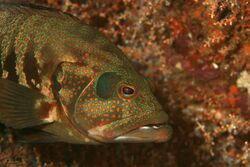Biology:Pseudorhabdosynochus urceolus
| Pseudorhabdosynochus urceolus | |
|---|---|
| Scientific classification | |
| Domain: | Eukaryota |
| Kingdom: | Animalia |
| Phylum: | Platyhelminthes |
| Class: | Monogenea |
| Order: | Dactylogyridea |
| Family: | Diplectanidae |
| Genus: | Pseudorhabdosynochus |
| Species: | P. urceolus
|
| Binomial name | |
| Pseudorhabdosynochus urceolus Mendoza-Franco, Violante-Gonzalez & Herrera, 2011
| |
Pseudorhabdosynochus urceolus is a diplectanid monogenean parasitic on the gills of groupers. It has been described in 2011.[1]
Description
Pseudorhabdosynochus urceolus is a small monogenean. The species has the general characteristics of other species of Pseudorhabdosynochus, with a flat body and a posterior haptor, which is the organ by which the monogenean attaches itself to the gill of is host. The haptor bears two squamodiscs, one ventral and one dorsal. The sclerotized male copulatory organ, or "quadriloculate organ", has the shape of a bean with four internal chambers, as in other species of Pseudorhabdosynochus.
The vagina includes a sclerotized part, which is a complex structure. The specific name is derived from Latin (urceolus, a small jug or pitcher) and refers to the shape of the vagina.[1]
Hosts and localities
The graysby, Cephalopholis panamensis is the type-host of Pseudorhabdosynochus urceolus, and the type-locality is Taboga Island in Panama.[1]
References
- ↑ 1.0 1.1 1.2 Mendoza-Franco, Edgar F.; Violante-González, Juan; Rojas Herrera, Agustín A. (2011). "Six new and one previously described species of Pseudorhabdosynochus (Monogenoidea, Diplectanidae) infecting the gills of groupers (Perciformes, Serranidae) from the Pacific coasts of Mexico and Panama". Journal of Parasitology 97 (1): 20–35. doi:10.1645/GE-2716.1. ISSN 0022-3395. PMID 21348602.
Wikidata ☰ Q21325906 entry
 |


